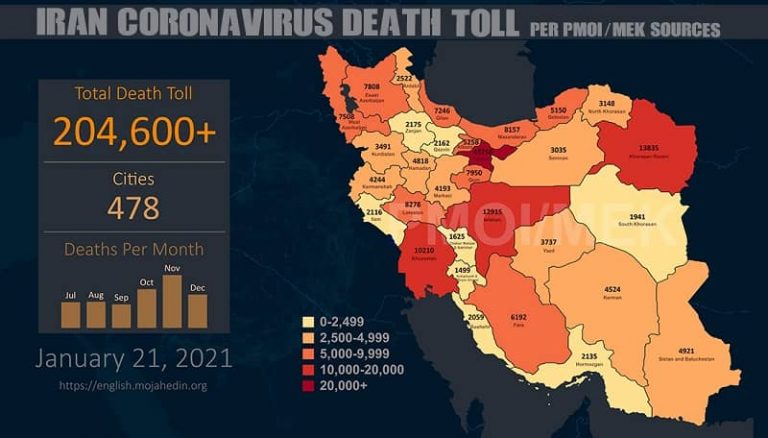Iran: Coronavirus Death Toll in 478 Cities Surpasses 204,600

Written by
Secretariat of the National Council of Resistance of Iran (NCRI)
Iraj Harirchi, regime’s Deputy Health Minister: The COVID-19 situation will get worse again. This time, we will not easily overcome the situation because our hospitals and medical staff have their problems. (Mehr news agency, January 21, 2021)
Alireza Zali, head of the National Coronavirus Combat Taskforce (NCCT) in Tehran: In Tehran, 1.8% of all COVID-19 indices have increased compared to last week, and in the past 24 hours, the number of hospitalizations has increased by 4.8% compared to the previous day. (ISNA news agency, January 21, 2021)
Mostafa Ghanei, head of the NCCT Scientific Committee: By the end of June 2021, we will have the Iranian vaccine ready for injection, and God willing, by September, there will be no shortage of vaccines. (State TV, January 20, 2021)
Despite imposing severe COVID-19 restrictions, Amol (a city north of Iran) has not yet come out of the red states, and the situation has worsened. (IRNA news agency, January 21, 2021)
Qom’s Medical Organization: In the past 24 hours, the Province’s COVID-19 positive tests have tripled, which indicates a mutation in the virus. (Tasnim news agency, January 20, 2021)
Kermanshah University of Medical Sciences: In the coming weeks, we will see an increase in hospitalizations, which is the alarm bell for the beginning of the fourth peak of the virus. (IRNA, January 21, 2021)
The People’s Mojahedin Organization of Iran (PMOI/MEK) announced on Thursday, January 21, 2021, that the Coronavirus death toll in 478 cities had exceeded 204,600. The number of victims in Tehran is 49,756, Isfahan 12,915, Lorestan 8,278, Mazandaran 8,157, Qom 7,950, Golestan 5,150, Hamedan 4,818, Kerman 4,524, Kermanshah 4,244, North Khorasan 3,148, Semnan 3,035, Zanjan 2,175, Qazvin 2,162, Ilam 2,116, Bushehr 2,059, and South Khorasan 1,941.
Despite concerns regarding the surge in the Coronavirus outbreak, due to Khamenei and Rouhani’s criminal policies, there are no clear prospects for vaccination. Mostafa Ghanei, director of the NCCT Scientific Committee, told the State TV yesterday, “By the end of June 2021, we will have access to the Iranian vaccine for injection, and I think, God willing, there will be no shortage of vaccines in September, and we can say that by the end of the year (another 14 months) vaccination will reach the point where we can break the virus chain.”
Secretariat of the National Council of Resistance of Iran (NCRI)
January 21, 2021

